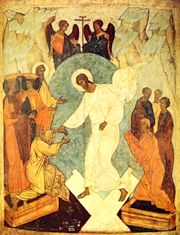Pascalia
| Acest articol (sau părți din el) este propus spre traducere din limba engleză!
Dacă doriți să vă asumați acestă traducere (parțial sau integral), anunțați acest lucru pe pagina de discuții a articolului. |
The Paschalion of the Orthodox Church combines the metonic and solar calendrical cycles to determine the date of Pascha for a given year. A common formula to determine the date of Pascha was created in connection with the First Ecumenical Council, held at Nicea in 325 A.D.
Cuprins
Formula niceeană
Începând cu 326 A.D.(primul an după Sinod), Pascha has been officially defined as the first Sunday following the date of the Paschal Full Moon ("PFM") for a given year. The PFM is not, however, as commonly thought, the first full moon following the vernal equinox. Rather, the PFM is the first Ecclesiastical Full Moon ("EFM") date that follows March 20. EFMs are calendar dates that approximate the cycle of astronomical full moons (usually falling within 1-3 days of an astronomical full moon), which repeats every 19 years. March 20 is the date used for determining the PFM because it was the vernal equinox in 325 A.D., the year the EFM cycle was determined by astronomers.
Because of the inaccuracy of the Julian Calendar, Pascha is drifting later into the year for those who use the Julian Paschalion. Thus, while according to the calendar, for those using the Julian Calendar Pascha will always be sometime in March or April, it will eventually be celebrated in the northern hemisphere in the summer, the autumn, and then the winter. For those using the Revised Julian Calendar, the calendar date of Pascha is drifting along with its astronomical position. The Gregorian Calendar, which includes its own revised Paschalion, has neither of these problems.
Reforma gregoriană
În Octombrie 1582, Biserica Romano-Catolică adopted a major calendar reform designed to correct for the 10-day drift in the vernal equinox since the First Ecumenical Council. The Julian calendar then in common use was based on an average year of 365.25 days, slightly longer than the actual solar mean year of 365.24219 days.
Noul calendar a fost numit gregorian după cel care a iniţiat această reformă, papa Grigorie al XIII-lea. The reform also introduced refinements to the calculation of Pascha.
Răsăritul şi Apusul astăzi
The Roman Catholic and Protestant West eventually adopted the Gregorian Calendar for civil and ecclesiastical purposes, including the determination of Pascha. The Orthodox East, however, was not so quick to change. Even when the traditionally Orthodox countries began to adopt the Gregorian Calendar for civil purposes, the Orthodox Church retained the Julian Calendar and original Paschalion. For the sake of convenience, the date of Pascha is often transposed to the coincident date on the Gregorian Calendar for reference.
Because of the difference in calendars and formulas, Western Easter and Orthodox Pascha do not often coincide. Generally, Orthodox Pascha follows Western Easter by between 1 and 5 weeks.
Algoritmi
Un număr mare de matematicieni au alcătuit diferiţi algoritmi pentru a calcula data Paştelui Ortodox de-a lungul secolelor. This simple and elegant one was devised by the brilliant mathematician Jacques Oudin in the 1940s:
N.B. -- In this formula MOD is the modulus function, in which the first number is divided by the second and only the remainder is returned. Further, all division is integer division, in which remainders are discarded. Thus 22 MOD 7 = 1 but 22 / 7 = 3.
G = year MOD 19 I = ((19 * G) + 15) MOD 30 J = (year + (year/4) + I) MOD 7 L = I - J Easter Month = 3 + ((L + 40)/44) Easter Day = L + 28 - 31 * (Easter Month/4)
Easter Month will be a number corresponding to a calendar month (e.g., 4 = April) and Easter Day will be the day of that month. Note that this returns the date of Pascha on the Julian calendar. To get the corresponding date on the Gregorian calendar, add 13 days (14 days after March 1, 2100).
Program de calculat Pascalia
Puteţi afla data Paştelui şi a altor sărbători dependente de Paşti(e.g., începutul Postului Mare, Duminica Rusaliilor, etc.) cu ajutorul programului online JavaScript Paschalion utility (este recomandat Internet Explorer3 sau Netscape 3).
This site allows the user to enter a year and uses Oudin's algorithm to compute the relevant dates. Although the Orthodox (Julian-based) formulas are used, the utility returns the corresponding Gregorian calendar dates. For example, in 2006 Pascha falls on Sunday, April 10, on the Julian calendar. That date corresponds to April 23 on the Gregorian calendar.
A perpetual Paschalion utility is available here. The utility was created by Aleksandr Andreev of Duke University and calculates Pascha and associated feasts for any series of years. It also calculates the numbers used in Paschal calculations which can be found in an Orthodox Typicon.
Link-uri interne
Link-uri externe
- Concerning the Date of Pascha and the 1st Ecumenical Council, de Arhiepiscopul Petru (L'Huillier) al New York-ului
- The Calendar Issue in the Orthodox Church, de John Parsells (PDF)
- Frequently Asked Questions about Calendars de Claus Tondering (totul despre calendar)
- Calendar and Easter Topics
